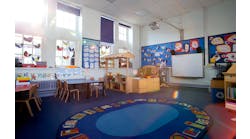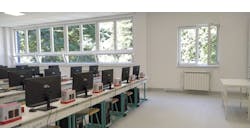As a source of light, windows on old school buildings were taken for granted. Teachers could control the lighting in a classroom by tilting the 2-inch blinds or closing the roller shade. Skylights or lightwells brought light into internal parts of the building. Looking at old school buildings, some of the most prominent features are the windows, skylights and light courtyards. Until the 1950s, natural light was the predominant way most school spaces were illuminated. As the cost of electricity decreased, more electric lighting was installed, and the amount of daylighting used in schools decreased.
During the 1970s energy crisis, many windows and skylights in older facilities were closed in or covered up; on new buildings, windows and skylights were reduced to small punched openings in an insulated facade or roof. Natural light was replaced with electric lighting. Designers and educators felt this would provide a better learning atmosphere without glare, and students would not be distracted by activities outside the windows.
Out of the dark
Today, windows and skylights again are becoming important features on school buildings. Why are skylights and windows reappearing when we have electric lighting, which easily can provide the required lighting in an educational environment?
A couple of reasons:
-
Daylighting is provided by the sun at no cost beyond the cost of a window or skylight.
-
Teachers prefer natural light and windows that can be opened, and the enhancement that natural light brings to a building's interior.
-
Studies indicate that natural light can enhance student performance, provided that it is not accompanied by glare. Studies also suggest that daylighting spaces can boost overall health and physical development, encourage increased student attention and promote better behavior. Other studies support the theory that interesting window views enhance, rather than detract, from student learning.
History and knowledge have shown that daylighting, along with appropriate electrical lighting, is required to provide environments conducive to learning. Lighting needs to provide a varying level of lighting from about 30 fc (footcandles) at computer areas to 50 to 70 fc for desktop reading and writing. With computers in the classroom and portable computers, light systems need to be flexible and controllable.
Daylighting will reduce the amount of electric lighting required, thus saving the direct energy costs of turning lights on, as well as reducing the amount of air conditioning required to remove the heat generated by lights. Passive solar gains in the winter also can reduce heating costs. Reductions in the cooling and heating loads by incorporating daylighting can reduce the size of equipment, leading to a reduction in the initial cost of equipment. Daylighting also is a sustainable energy source, which is environmentally friendly.
General considerations
Proper planning and design is needed to experience the benefits of windows and skylights, and avoid unintended effects that may detract from student performance. These negative effects may include glare, overheating of the space, and visual or noise disruptions. The design should take into account the orientation, shading, tints, and insulation qualities of the glazing. It should show a clear understanding of what activities will take place inside the windows and under the skylights. Double-glazed windows with thermal breaks are beneficial in all but the most temperate climates.
Facilities managers should look at every building individually in order to incorporate the positive aspects of daylighting. They should give careful consideration to the elevation of a building, as well as the climate. New buildings on open sites can be oriented to use solar lighting to maximize north and south exposures while minimizing east and west exposures. New buildings on restricted sites or existing buildings may not allow maximum benefit, but should provide ample opportunities to take advantage of natural daylighting. Historically significant buildings that are renovated or adaptively reused may pose additional challenges for preserving or restoring the exterior appearance.
Spaces that incorporate technology or multimedia require the most flexible and controlled lighting. Lobbies and gathering spaces could benefit from direct sunlight and shadows, providing students a bright, sunny spot on a cold winter day. Skylights and windows at the ends and intersections of corridors can provide the psychological impression of a shorter corridor. Skylights can be used to introduce natural light into the centers of large buildings, with daylight “borrowed” by internal classrooms.
Noise and visual distractions also should be considered. Glazing systems are designed to reduce the noise transmission into a space. Sill heights should be raised or window sizes reduced if activities outside the window attract a student's attention beyond “window gazing” and eye relief.
Maintenance and safety
Windows should be placed where the maintenance staff can clean both sides regularly, or be provided with operators to allow cleaning from one side. Windows can break and may need to be replaced during the school year; therefore, they should be designed in standard sizes for quick replacement.
Windows that cannot be reached easily from the interior should be glazed from the exterior, provided that they would not be easily accessible to the general public. Durable glass block can be used as windows in gymnasiums and locker rooms.
Traditional skylights have raised safety concerns. Skylights should be vandal-resistant and have guards, or be constructed of materials that will prevent a person from falling through the opening. The other option is to provide vertical windows in a “clerestory area” or “monitor.”
Controlling glare
Windows are the most common way to provide daylighting. Window design should be considered as part of a total lighting system, not just an aesthetic issue of how a building looks from a street or parking lot.
Controlling light through vertical windows can be handled with many items, but typically the most efficient are overhangs to prevent direct sunlight, horizontal louvered blinds, roller blinds, tints and blackout shades. Light shelves, which allow light to bounce off, can be used to direct natural light deeper into a room.
Skylights and monitors used to bring light into a room through the roof should have baffles or reflectors to prevent direct sunlight from entering the educational space. Blackout shades should be provided to reduce or eliminate daylighting where dimming may be required.
If natural lighting is incorporated into the design of active spaces such as gymnasiums, sunlight should be controlled. This will help prevent injuries that can result when direct sunlight reflects off a shiny floor. Swimming pools are one area where natural light is always requested, but must be controlled carefully; glare on the water's surface can prevent a lifeguard from seeing all parts of a pool.
Chambers, NCARB, AIA is a principal with Bink Partnership, Camp Hill, Pa., and serves as director of the Pennsylvania Schoolhouse Studio, which specializes in exploring the best practices in education to provide program-based solutions to the educational community.
NOTABLE
History and knowledge have shown that daylighting, along with appropriate electrical lighting, is required to provide environments conducive to learning.
-
30
Approximate number of footcandles required at computer areas.
-
50 TO 70
Approximate number of footcandles required for desktop reading and writing.
SIDEBAR: A renovation challenge
The Warwick Building, Pottstown, Pa., was built as a two-room community school in 1927, enlarged to eight classrooms with a wraparound addition in the early 1930s, and further expanded to include a gymnasium with lower-level locker rooms within a 1940 addition. When the Owen J. Roberts School District was formed and a consolidated high school was built, the Warwick building became an elementary building. In 2001, the students were moved into a nearby elementary school that recently had been enlarged and renovated.
The existing building is within the flood plain in a sensitive watershed area and scenic river corridor, which limited the ability to expand and renovate as a more efficient elementary facility. The building is considered a local landmark, and the township required the look of the building's exterior to remain virtually unchanged, especially the windows. The building recently reopened as the district's business office and technology center, and includes conference rooms and classrooms for administrative use and faculty training.
Because of the township's requirement, making the new, oversized, thermally broken, insulated windows look like the existing single-pane, double-hung windows or steel windows was a challenge. The district wanted the windows to be easy to clean and equipped with integral horizontal louver blinds. The building's orientation was fixed and benefited from large amounts of natural light, but the existing openings had to be used, while lowering the ceiling and accommodating many lighting levels for office spaces, meeting rooms, classrooms and computer labs.
The design used thermally broken aluminum windows with integral blinds with applied muntins on the exterior face, and low-e glazing. Single-hung windows replicate the existing double-hung windows and project with fixed windows to replicate the steel system. The windows' interiors are undivided panes of glass, which are easy to clean, and the blinds allow for individual adjustment. Each space is provided with two lighting levels, including a strip light on the dropped soffit in order to take advantage of daylighting.

